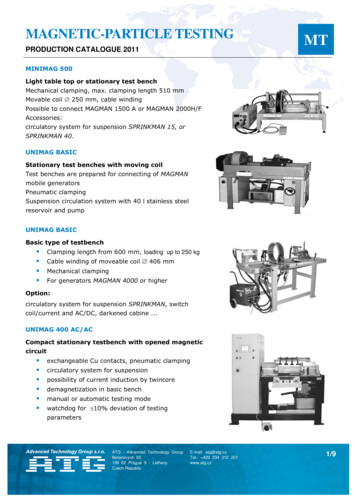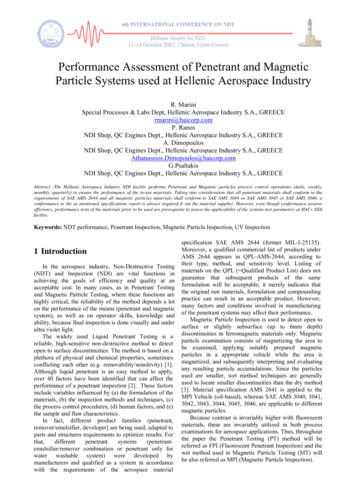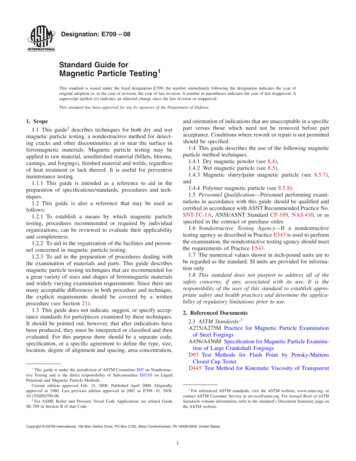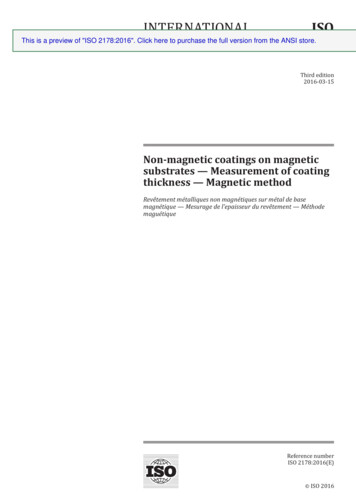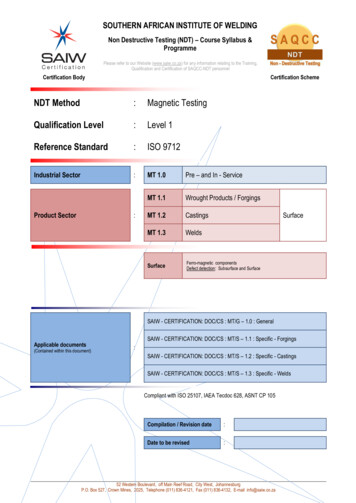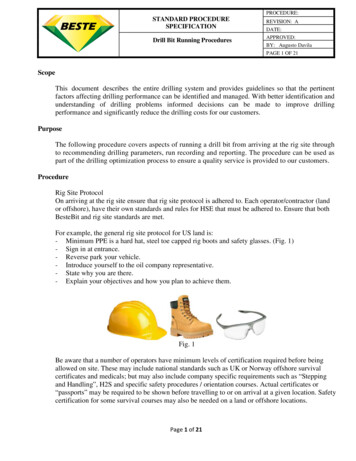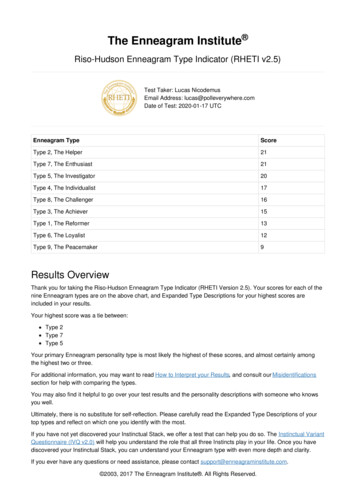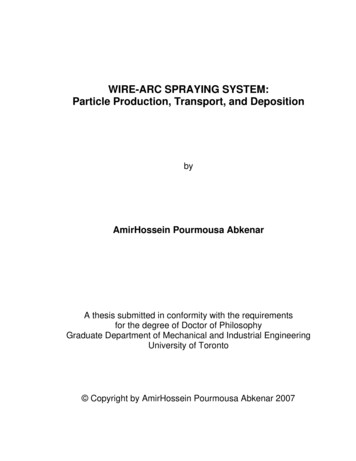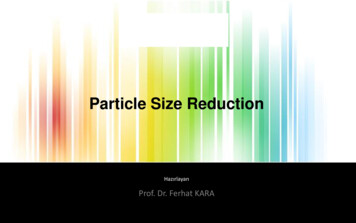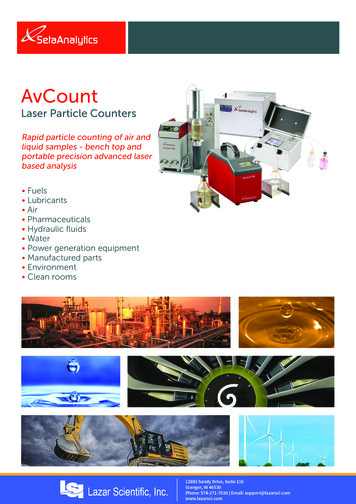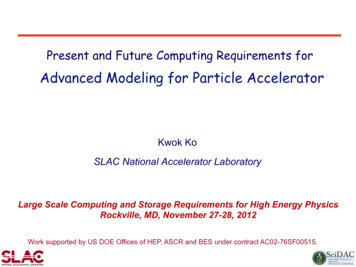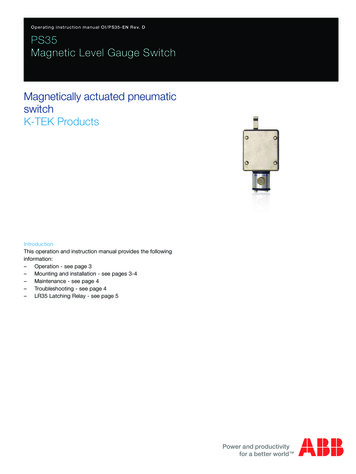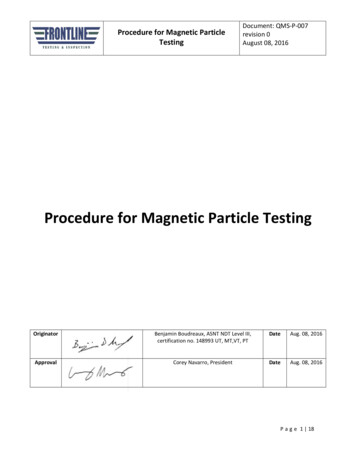
Transcription
Procedure for Magnetic ParticleTestingDocument: QMS-P-007revision 0August 08, 2016Procedure for Magnetic Particle TestingOriginatorBenjamin Boudreaux, ASNT NDT Level III,certification no. 148993 UT, MT,VT, PTDateAug. 08, 2016ApprovalCorey Navarro, PresidentDateAug. 08, 2016P a g e 1 18
Procedure for Magnetic ParticleTestingDocument: QMS-P-007revision 0August 08, 2016Revision HistoryRevision levelOriginalDescription of RevisionsProcedure for Magnetic Particle Testing was createdDate8-08-2016P a g e 2 18
Procedure for Magnetic ParticleTestingDocument: QMS-P-007revision 0August 08, 20161. Scope1.1 This procedure establishes the steps and details to be followed for the examination of ferromagneticmaterial, both structural and non-structural welds, drilling or production equipment, raw, semi-finished, andmachined surfaces. Continuous (active), true-continuous and residual techniques with the wet visible, wetfluorescent and dry particle applications are discussed in this procedure for the detection of surface breakingor near surface discontinuities in ferromagnetic materials.2. Referenced Documents2.1 ASTM E1444 – Standard Practice for Magnetic Particle Testing, latest edition2.4 ASTM E709 – Standard Guide for Magnetic Particle Testing, latest edition2.5 ASME Section V, Article 7 – Standard for Magnetic Particle Testing, latest edition2.6 ASNT SNT-TC-1A – R.P. for the Qualification and Certification of NDT Personnel, latest edition2.7 AWS D1.1 – Structural Welding Code – Steel, latest edition3. Personnel Qualification3.1 Personnel performing inspections to this procedure shall be qualified and certified in accordance with ASNTSNT-TC-1A latest edition and the Company’s personnel qualification procedure, QMS-P-005, latest edition.3.2 Only those personnel certified Level II or higher in the method being employed are allowed to performinspections in accordance with this procedure.4. Definitions4.1 True-continuous technique - is the technique whereby the particle medium is applied just as the electricalmagnetizing current is turned on; the particle application is then diverted with the electrical currentremaining on and the actual inspection performed also with the current remaining on4.2 Indirect magnetization - is the technique in which the magnetizing electrical current flows through anelectrical conductor; the test specimen does not become part of the electrical circuit4.3 Continuous technique - is the technique whereby the particle medium is applied just as the electricalmagnetizing current is turned on; the particle application is then diverted with the electrical currentremaining on for not less than 3 seconds or with the addition of at least two shots; inspection may then beperformed with the electrical magnetizing current turned off4.4 Residual technique - is the technique whereby the electrical magnetizing current is turned on and a residualfield is then induced in the test specimen; the current is then de-energized and the particle medium is thenapplied, then diverted and the inspection performed; inspection is then performed with the electricalmagnetizing current turned off5. TechniqueP a g e 3 18
Procedure for Magnetic ParticleTestingDocument: QMS-P-007revision 0August 08, 20165.1 This procedure recognizes the following techniques:- Technique 1 - Yoke, AC, True-Continuous, Visible Wet, Visible Dry Inspection- Technique 2 - Yoke, AC, True-Continuous, Wet Fluorescent Inspection- Technique 3 - Coil/ Cable Wrap, AC, DC, FWDC or HWDC, True-Continuous or Continuous or Residual,Wet Fluorescent or Visible Dry Inspection- Technique 4 - Central Conductor, AC, DC, FWDC or HWDC, True-Continuous or Continuous or Residual,Wet Fluorescent or Visible Dry Inspection5.2 Residual techniques are typically, not as sensitive as continuous and true-continuous techniques.6. Inspection Equipment6.1 The following equipment will be required as applicable regardless of the technique used.6.1.1 Cleaning equipment: Appropriate cleaning agents may include degreasers, detergents, soap andwater, brushes, buffers, scrapers or paint stripper6.1.2 Mirrors, as applicable6.1.3 Field Indicator: Type G Castrol strip or Pie gauge as described in ASTM E709 and E14446.1.4 White light meter6.1.5 Fluorescent light meter6.1.6 Centrifuge (100mL)6.1.7 White light source6.1.8 Fluorescent UV-A light source (Black light)6.2 The following equipment depends on the technique used.Technique 1 and 2 – AC Yoke– 10 # test block for the AC yoke– Black visible wet particle, Yellow, Red, Gray, Blue visible dry particle or Fluorescentwet particle– White highlighter for use with the visible wet and dry applications when necessaryTechnique 3 – AC, DC, FWDC or HWDC Coil or Cable Wrap (Copper Cable)– Pocket gauss meter– Yellow, Red, Gray, Blue visible dry particle or Fluorescent wet particleP a g e 4 18
Procedure for Magnetic ParticleTestingDocument: QMS-P-007revision 0August 08, 2016– Main Magnetizing Unit: Portable or fixed bench units with adequate power supply. Allcurrent (amperage) meters shall exhibit a re-calibration sticker. OR– Capacitor Discharge Unit (Residual or Continuous field inspection): Capacitor discharge (CD)units shall be classed and used as in API RP 5A5, if applicable. A 10,000 A (peak), “shortduration” capacitor discharge may be usedTechnique 4 – Copper cable or copper or aluminum rod– Pocket gauss meter– Yellow, Red, Gray, Blue visible dry particle or Fluorescent wet particle– Main Magnetizing Unit: Portable or fixed bench units with adequate power supply. Allcurrent (amperage) meters shall exhibit a re-calibration sticker. OR– Capacitor Discharge Unit (Residual or Continuous field inspection): Capacitor discharge (CD)units shall be classed and used as in API RP 5A5, if applicable. A 10,000 A (peak), “shortduration” capacitor discharge may be used7. Preparation7.1 Lighting Requirements7.1.1 Minimum White Light LevelWhen conducting visible magnetic particle inspection the minimum ambient white (daylight, orindoor facility) light intensity at the inspection surface shall be 100 foot candles (1076 lux), orcustomer-stated requirements if higher.7.1.2 Minimum Black Light LevelWhen conducting fluorescent magnetic particle inspection the UVA (Black light) bulbs must bemercury vapor 100 W minimum bulbs with minimum intensity at a distance of 15” of 1000microwatts/ cm2. Allow sufficient time (e.g. 10 minutes) for bulbs to warm up to provide fullintensity. The black light shall operate only in the UV-A part of the light spectrum.7.1.2.1 Lenses: Photosensitive eye glasses/lenses shall not be worn by the inspector performing UVA light inspections.7.1.3 Darkened Examination AreaWhen conducting fluorescent magnetic particle inspection a black light tent, or a cape should beused to provide a darkened area. Black light tents are preferred. The white light intensity in theviewing area shall not be more than 2 foot candles (21.5 lux). Five minutes must be allowed for eyeadaptation to the darkened area.7.2 Cleaning Requirements7.2.1 All surfaces or welds to be inspected plus 1” of adjacent material shall be cleaned such that grease,oil, scale, dirt, paint, slag, weld spatter or any other foreign matter deemed by the Level II asobstructing the inspection is removed.P a g e 5 18
Procedure for Magnetic ParticleTestingDocument: QMS-P-007revision 0August 08, 20167.2.2 Upon completion of the cleaning operations the areas to be inspected must be completely dry priorto the start of the inspection.7.3 Particle Requirements7.3.1 Wet Fluorescent Particle7.3.1.1 Suspension fluid shall be a solvent with low sulfur content; Safety clean, Varsol or water.Other comparable solutions may be used. (Gasoline or diesel shall not be used.) Surfacetension reducers shall be added to water solutions. Premixed aerosol spray may be used.7.3.1.2 Particle Concentration: Wet fluorescent particle strength shall range from a minimum of 0.1to 0.4 ml/100 ml of solution, measured utilizing a centrifuge tube for 60 minutes (30 minuteswith water). Particle concentration shall be checked prior to the commencement of a job,and at least every 8 hours thereafter.7.3.2 Wet Visible Particle7.3.2.1 Suspension fluid shall be a solvent with low sulfur content; Safety clean, Varsol or water.Other comparable solutions may be used. (Gasoline or diesel shall not be used.) Surfacetension reducers shall be added to water solutions. Premixed aerosol spray may be used.7.3.2.2 Particle Concentration: Wet visible particle strength shall range from a minimum of 1.2 to2.4 ml/100 ml of solution, measured utilizing a centrifuge tube for 60 minutes (30 minuteswith water). Particle concentration shall be checked prior to the commencement of a job,and at least every 8 hours thereafter.7.3.2.3 Contrast: Particles shall have a high contrast with the inspected surface. Nonmagneticsurface contrast paint may be applied to uncoated surfaces to enhance particle contrast. Thecontrast coating shall be very light with just enough to contrast with the particles. In anycase the coating shall not exceed 0.002” (2 mils).7.3.3 Visible Dry Particle7.3.3.1 Contrast: Dry particles shall have a high contrast with the inspected surface. Nonmagneticsurface contrast paint may be applied to uncoated surfaces to enhance particle contrast. Thecontrast coating shall be very light with just enough to contrast with the particles. In anycase the coating shall not exceed 0.002” (2 mils).7.3.3.2 Particle Sizes: Dry particles shall meet the requirements of API RP 5A5 and ASME.7.4 Equipment Calibration Requirements7.4.1 The following equipment shall be calibrated or have the calibration verification performed not lessthan every 6 months or anytime there is question as to the accuracy of the equipment.7.4.1.1 AC YokeP a g e 6 18
Procedure for Magnetic ParticleTestingDocument: QMS-P-007revision 0August 08, 20167.4.1.2 Fixed Coil (Shall have the number of turns marked on the coil)7.4.1.3 White light meter7.4.1.4 Fluorescent light meter7.4.1.5 Pocket gauss meter7.4.1.6 Main magnetizing unit7.4.1.7 Capacitor discharge unit7.4.2 Calibrated equipment must be serialized and evidence of calibration or calibration verification mustbe maintained.7.4.3 Concerning the 10lb. test block; these blocks must be serialized and have evidence that the weightwas verified on a calibrated scale not less than every 3 years. No major deformity in the block shall betolerated.7.4.4 Yokes shall be verified as being able to lift the 10lb. block.7.4.4.1 The AC Yoke must be able to lift the 10lb. block at the maximum leg spacing to be used.7.4.4.2 Regardless of the inspection technique the yoke shall never be used with a leg spacing of lessthan 2”.7.4.4.3 AC yokes are typically used to examine weld preparation areas, welds in pressure retaining orstructural materials using dry, fluorescent and wet visible particles. Yokes may also be usedto examine larger parts such as forgings or castings prior to final machining, including weldrepairs. Field strength of the magnetic yoke shall be verified.7.5 Inspection system verification requirements7.5.1 Regardless of the technique used, the employment of either the Castrol Strip or Pie-gauge shallalways be used to verify system performance, sensitivity and field direction.7.5.2 The strip shall be held on the part at least once per ten similar areas inspected. In use, a magneticparticle indication shall be visible on all 3 slots in the strip.7.6 General Inspection Requirements7.6.1 Dry particle inspections cannot be performed in windy conditions. Surfaces shall be cleaned and dryat the start of any inspection so performing any of these techniques in the rain is prohibited.7.6.2 If the part or material to be inspected is found to have a residual field that will interfere with theexamination the part must be either demagnetized to the degree that it will not interfere with theinspection process or enforced with the magnetizing equipment.P a g e 7 18
Procedure for Magnetic ParticleTestingDocument: QMS-P-007revision 0August 08, 20167.7 Length to Diameter Ratio Requirements7.7.1 For parts with an L/D ratio equal to or greater than 4”NI 35000 / (L/D) 2)7.7.2 For parts with an L/D ratio less than 4, but greater than 2”NI 45000 / (L/D)Where: N is the number of effective coil turnsI is the current in Amperes (A)L/D is the ratio of the length to diameter of the component of circular section7.7.3 Concerning coils; a coil with the rated capability to induce a longitudinal magnetic field of at least1,200 A/T per inch of connection OD is required however; consideration for effective diameters mustbe considered as described in the applicable ASTM standards.7.8 Temperature Requirements7.8.1 Solution/Part Temperature Limits: The temperature of the solution shall not exceed 110 F (43 C). Thesurface under examination shall not exceed 135 F (57 C). The temperatures of the solution and partsurface shall be within 25 F ( 14 C) of each other.7.9 Polarity Check for Coil Utilization7.9.1 Technician shall determine polarity of the existing magnetic field, if any, in each end of the part to betested utilizing a pocket gauss meter. Each end of the part shall be marked as positive “ ” or negative“-“, as applicable.7.9.2 The coil shall be placed on the part so as to reinforce the field and not oppose it.8. ProcedureRegardless of the technique employed, 1” of the adjacent material shall be inspected. In the case of weldinspection 1” of the parent material measured from either toe of the weld shall be inspected.8.1 Technique 1 - Yoke, AC, True-Continuous, Visible Wet, Visible Dry Inspection8.1.1 Visible Wet Inspection: A longitudinal magnetic field will be induced by way of the AC yoke. Lightingrequirements should be met prior to the start of the inspection.8.1.1.1 A white, flat, contrasting background may be applied using a very thin layer of contrastaerosol highlighter.8.1.1.2 Wet magnetic particles shall be applied over the areas to be inspected jus
magnetizing current turned off : 5. Technique : Procedure for Magnetic Particle Testing Document: QMS-P-007 revision 0 August 08, 2016 Page 4 18 : 5.1 This procedure recognizes the following techniques: - Technique 1 - Yoke, AC, True-Continuous, Visible Wet, Visible Dry Inspection - Technique 2 - Yoke, AC, True-Continuous, Wet Fluorescent Inspection - Technique 3 - Coil/ Cable Wrap, AC, DC .
